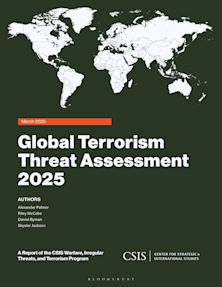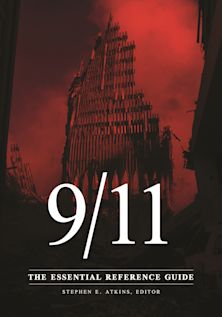- Home
- ACADEMIC
- Politics & International Relations
- Security and Strategic Studies
- Strategy for Empire
Strategy for Empire
U.S. Regional Security Policy in the Post-Cold War Era
Brian Loveman (Author) , George W. Bush (Contributor) , Richard G. Catoire (Contributor) , Jonathan Graubart (Contributor) , Dipak K. Gupta (Contributor) , Michael Ignatieff (Contributor) , Chalmers Johnson (Contributor) , Ralph Peters (Contributor) , James A. Russell (Contributor) , Lars Schoultz (Contributor) , Donald E. Schulz (Contributor) , Andrew Scobell (Contributor) , Raju G. C. Thomas (Contributor) , Juan G. Tokatlian (Contributor) , Celeste A. Wallander (Contributor) , Robert Wilkie (Contributor) , Stephen Zunes (Contributor)
- Textbook
Strategy for Empire
U.S. Regional Security Policy in the Post-Cold War Era
Brian Loveman (Author) , George W. Bush (Contributor) , Richard G. Catoire (Contributor) , Jonathan Graubart (Contributor) , Dipak K. Gupta (Contributor) , Michael Ignatieff (Contributor) , Chalmers Johnson (Contributor) , Ralph Peters (Contributor) , James A. Russell (Contributor) , Lars Schoultz (Contributor) , Donald E. Schulz (Contributor) , Andrew Scobell (Contributor) , Raju G. C. Thomas (Contributor) , Juan G. Tokatlian (Contributor) , Celeste A. Wallander (Contributor) , Robert Wilkie (Contributor) , Stephen Zunes (Contributor)
- Textbook
Buy from Bloomsbury eTextBooks
You are now leaving the Bloomsbury Publishing website. Your eBook purchase will be with our partner https://www.vitalsource.com.
Your credit card statement will show this purchase originating from VitalSource Technologies. They will also provide any technical assistance you might require.
You must sign in to add this item to your wishlist. Please sign in or create an account
Description
The United States Department of Defense has carved the world into five pieces, called unified military commands, maintaining troops and military leadership in each. The geographic boundaries of the unified commands, which together encompass the entire globe, 'are set in a way that makes sense to us (the U.S.) for political, military, cultural sorts of reasons,' according to the DOD. Yet outside military and defense circles, the potential impact of post-1990 American strategic reach_or perhaps overreach_has not been given sufficient attention. In Strategy for Empire, Brian Loveman fills that gap by raising the key questions all students should be considering: Even under the perilous conditions imposed by global terrorism, diffusion of weapons of mass destruction, and international 'anarchy,' can the United States afford, and should it seek to justify, assigning responsibility to combatant commanders for every area of the globe and maintaining a military presence in well over 100 countries? Can a foreign policy of preemptive deterrence and covert operations around the globe against terrorists, international criminal organizations, and so-called rogue states be compatible with American constitutional democracy? Or has the United States itself become a rogue superpower, at risk of losing its democratic soul and institutions at home and its moral credibility abroad in its efforts to manage a global empire through regional military commands? This timely reader provides answers to these questions from the perspective of American presidents, policymakers, military officers, establishment think tanks, and critical scholars. The text and accompanying CD collect in one place a synthesis of official and semi-official views of post-1990 regional security agendas and of the evolving perception of post-Cold War threat scenarios. The book begins with President George Bush's 'The National Security Strategy of the United States of America' ( September 2002); then presents the views of military strategists, government policymakers, and 'mainline' think tanks; followed by alternative, critical views from leading experts on U.S. security policy. The accompanying CD sends readers directly to major policy documents and studies described in the text. The CD also includes an extensive bibliography of secondary works that focus on regional security policy during the post-Cold War period. The book and CD combined offer teachers a unique resource, providing a wealth of stimulating material for the classroom that is sure to promote critical thinking and spark lively discussion and debate.
Table of Contents
Product details
| Published | 06 Aug 2004 |
|---|---|
| Format | Ebook (Epub & Mobi) |
| Edition | 1st |
| Extent | 384 |
| ISBN | 9781461618386 |
| Imprint | Rowman & Littlefield Publishers |
| Series | The World Beat Series |
| Publisher | Bloomsbury Publishing |
About the contributors
Reviews
-
This timely book offers a tour of different perspectives on the purpose and role of American power in the contemporary era, demonstrates how this global context is likely to shape regional security arrangements over the coming years, and considers the range of consequences of American foreign policy on regional developments.
Michael Barnett, University of Wisconsin-Madison
-
Strategy for Empire offers readers a balanced and insightful interpretation of the most momentous global issue of our time-whither America? What makes this volume so valuable is its analysis of this question from a variety of regional and political angles. Brian Loveman is to be commended for pulling together such a collection so effectively.
Richard A. Falk, Albert G. Milbank Professor of International Law Emeritus, Princeton University
-
Strategy for Empire is a well-balanced collection of primary and secondary resources to help students think critically about one of the key questions confronting the world today-will the United States be a constructive or destructive leader? Neither Democrats nor Republicans escape scrutiny, and the authors writing specifically for this volume help us see the continuity in U.S. foreign policy as well as the new twists under the current Bush administration. There is plenty of material here for a lively discussion at the undergraduate or graduate level, and the CD-ROM is a handy resource.
David R. Mares, University of California, San Diego



































